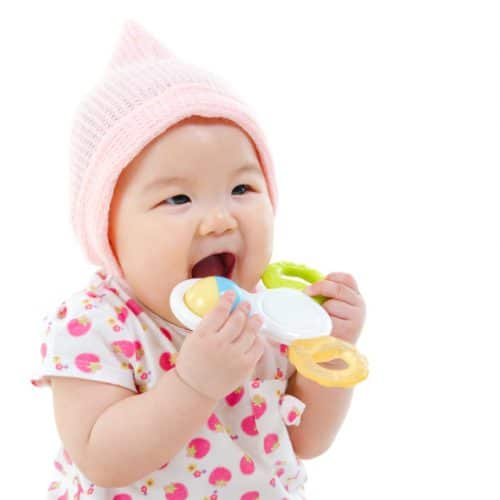Mold growing inside of rubber teething toys may cause illness.
 A discovery about a popular baby teething toy, Sophie the Giraffe, has parents across the country worried about the safety of these types of items. A pediatric dentist in New Jersey cut open the toy after noticing that it had a bad odor. Inside, she discovered mold — alarming many parents after the pictures of the mold were posted online. Other parents cut open their kids’ Sophie the Giraffe toys and also found mold inside.
A discovery about a popular baby teething toy, Sophie the Giraffe, has parents across the country worried about the safety of these types of items. A pediatric dentist in New Jersey cut open the toy after noticing that it had a bad odor. Inside, she discovered mold — alarming many parents after the pictures of the mold were posted online. Other parents cut open their kids’ Sophie the Giraffe toys and also found mold inside.
The giraffe is a relatively expensive teething toy at $25. It is made from rubber from Heavea trees, and marketed as all natural. Its shape allows babies to reach even their back teeth when chewing to alleviate teething pain. More than 50 million Sophie the Giraffe toys have been sold around the world. Experts believe that a small hole at the bottom of the giraffe — which allows babies to squeeze it — lets in moisture, which then can lead to mold growth.
According to the company that manufactures Sophie the Giraffe, mold should not be a problem if parents follow the cleaning instructions that are included with the toy. This means washing the giraffe toy regularly in either hot, soapy water or in the dishwasher. Parents can further disinfect the giraffe and other rubber toys by soaking them in a diluted bleach solution and allowing them to thoroughly air dry.
The discovery of mold in Sophie the Giraffe and other rubber toys meant for kids to put into their mouths raises questions about whether these products have a defective design that could cause injury to infants. While no illness or injuries have been reported and the giraffe has not been recalled, there are known side effects to mold exposure — particularly for people who are allergic to mold or whose immune systems are compromised. If a baby develops a sickness after chewing on a mold-filled toy, then it may lead to a products liability lawsuit.
Products liability cases are based on the idea that the products we purchase and use should be safe. There are three ways that a product can be defective: in its design, manufacture, or if the company fails to warn consumers of potential dangers. If the giraffe was made with a bad batch of rubber, causing pieces of the toy to break off in babies’ mouths, that could be an example of a manufacturing defect. If the company did not warn parents that mold could form if they did not clean the giraffe properly, that may be an example of a failure to warn. And if the hole in the bottom of the giraffe makes the product dangerous because it allows mold to grow, that could be an example of a design defect.
If you believe that your child has suffered an illness or injury due to a defective product such as Sophie the Giraffe, an experienced products liability attorney can help you determine if you have a viable claim. At the Law Offices of Larry H. Parker, our attorneys have helped more than 100,000 people recover for their injuries. We offer free initial consultations, where we can help you evaluate your legal rights and options, and we never charge our clients a fee unless we recover money for them. Contact our office today at 800-333-0000 or info@larryhparker.com to learn more or to schedule an appointment.



